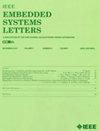An Endogenous Security Study of Telematics Box in Intelligent Connected Vehicles
IF 2
4区 计算机科学
Q3 COMPUTER SCIENCE, HARDWARE & ARCHITECTURE
引用次数: 0
Abstract
Intelligent connected vehicles (ICVs) are the result of technological advancements in the new era, greatly enhancing the driving experience. However, due to the complex nature of the system, the intelligence of devices, and the connectivity of data, a complex physical fusion system has been created. The in-vehicle Telematics Box (T-Box), serving as the central communication and data hub, faces challenges, such as network vulnerabilities, data privacy, and malicious attacks through untrusted software updates. Therefore, an in-vehicle T-Box with high reliability, security, and performance is an urgent product in the era of the Internet of Vehicles. This article investigates the endogenous security of the T-Box in ICV, with a focus on the integration of dynamic heterogeneous redundancy (DHR) architecture. The underlying idea is to transform the original system into multiple heterogeneous systems, where some of them handle the same business functions. By applying a consensus mechanism to detect malicious nodes and dynamically scheduling healthy nodes into the working mode, a self-purifying defense system with intrinsic security is formed. This design approach endows the T-Box with inherent defense capabilities against unknown vulnerabilities. Meanwhile, the in-vehicle T-Box is redesigned in the software and hardware implementation scheme. Experimental results demonstrate that the new design notably enhances and ensures the robust stability and elevated reliability of the in-vehicle T-Box. Evidently, the upgraded T-Box ensures the safe processing of in-vehicle CAN bus data.智能网联汽车车载信息箱的内生安全研究
智能网联汽车(ICVs)是新时代技术进步的结果,极大地提高了驾驶体验。然而,由于系统的复杂性、设备的智能化和数据的连通性,形成了一个复杂的物理融合系统。作为中央通信和数据集线器的车载远程信息处理箱(T-Box)面临着网络漏洞、数据隐私以及通过不受信任的软件更新进行恶意攻击等挑战。因此,高可靠性、高安全性、高性能的车载T-Box是车联网时代急需的产品。本文研究了ICV中T-Box的内生性安全性,重点研究了动态异构冗余(DHR)架构的集成。其基本思想是将原始系统转换为多个异构系统,其中一些系统处理相同的业务功能。采用共识机制检测恶意节点,动态调度健康节点进入工作模式,形成具有内在安全性的自净化防御系统。这种设计方法赋予T-Box针对未知漏洞的固有防御能力。同时,对车载T-Box进行了软硬件实现方案的重新设计。实验结果表明,新设计显著增强和保证了车载T-Box的鲁棒稳定性和高可靠性。显然,升级后的T-Box确保了车载CAN总线数据的安全处理。
本文章由计算机程序翻译,如有差异,请以英文原文为准。
求助全文
约1分钟内获得全文
求助全文
来源期刊

IEEE Embedded Systems Letters
Engineering-Control and Systems Engineering
CiteScore
3.30
自引率
0.00%
发文量
65
期刊介绍:
The IEEE Embedded Systems Letters (ESL), provides a forum for rapid dissemination of latest technical advances in embedded systems and related areas in embedded software. The emphasis is on models, methods, and tools that ensure secure, correct, efficient and robust design of embedded systems and their applications.
 求助内容:
求助内容: 应助结果提醒方式:
应助结果提醒方式:


